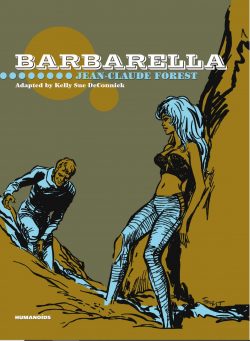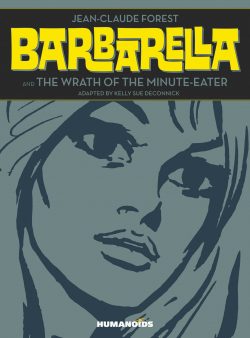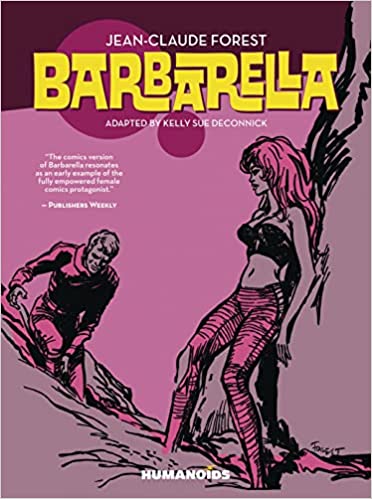

By Jean-Claude Forest, adapted by Kelly Sue DeConnick (Humanoids)
ISBN: 978-1-59465-533-3 (HB/Digital edition vol. 1) 978-1-59465-104-5 (HB/Digital edition vol. 2): 978-1-64337-883-1 (TPB combined 2 vols)
Europe’s post-war fascination with science fiction and baroque space opera arguably all stems from the innocently raunchy antics of a starry-eyed gamin holding forthright, ultra-modern views on sexual politics. Jean-Claude Forest’s Barbarella stimulated public acceptance of socially-inclusive futuristic themes in an era of Cold War and Atomic Anxiety: one that coincided with a highly publicised “sexual revolution” that was simultaneously beloved of and excoriated by screaming pundits and headline writers.
…And it all occurred just as France was locked into a momentary but absolute obsession with “sex kitten” Brigitte Bardot…
France’s love affair with speculative fiction actually goes back – at least – to the works of Jules Verne and maybe even as far as Cyrano de Bergerac’s posthumously published fantasy stories L’Autre Monde: ou les États et Empires de la Lune (The Other World: or the States and Empires of the Moon) and Les États et Empires du Soleil (The States and Empires of the Sun). They were first released in 1657 and 1662.
Happily for us, European comic iterations have always been groundbreaking, superbly realised and deeply enjoyable…
Proudly Parisian Forest (1930-1998) was a graduate of the Paris School of Design who began selling strips while still a student. His Fleche Noire (Black Arrow) feature opened a career illustrating for newspapers and magazines like France-Soir, Les Nouvelles Littéraires and Fiction throughout the 1950s. This was whilst producing Charlie Chaplin-inspired comic series Charlot and being chief artist for Hachette’s sci fi imprint Le Rayon Fantastique.
For this last client, Forest also produced illustrations and covers for translations of imported authors A. E. Van Vogt, Jack Williamson, and others.
Thus in 1962, with headlines trumpeting liberation and armageddon in the home and for the family, Forrest created Barbarella in V-Magazine. The innocently super-charged sex icon quickly took country and world by storm, generating an explosion of like-minded SF Bandes Dessinées features. Her first collected album was released by Editions Eric Losfeld in 1964, with further tales released until 1982. Those later stories were illustrated by Daniel Billon and the entire canon has never been out of print for long.
Forest never looked back, subsequently creating Baby Cyanide and more serious fare like Hypocrite; the Verne-inspired Mysterious Planet; La Jonque fantôme Vue de l’Orchestre and Enfants, c’est l’Hydragon qui Passe. He also found time to script for other artists: Les Naufrages du Temps (translated as Castaways in Time or Lost in Time) with Paul Gillon in 1964; Ici Meme for Jacques Tardi, and occult detective series Leonid Beaudragon for Didier Savard. These have been inexplicably all-but-ignored by English language publishers since the 1980s. If you read French, however, all are available in print and digitally…
The First Lady of Space sparked a Franco-Belgian fantasy mini-boom – classic series like Méziéres & Christin’s Valérian, Greg & Eddy Paape’s Luc Orient and Philippe Druillet’s Lone Sloane among so many others – thereby triggering the creation of dedicated periodical touchstone Métal hurlant in 1974.
At that time Forest was still finding new worlds for Barbarella to conquer, even though outside the Continent the concept was pretty much hijacked by Roger Vadim’s 1968 movie adaptation.
Here, however, we’re concentrating on Forest’s comics, as re-adapted and translated by Kelly Sue DeConnick (Bitch Planet, Pretty Deadly, Captain Marvel, Wonder Woman, Castle, Avengers). The stories then and now are very much in the manner of every British newspaper strip leading lady since Jane (so, see also Axa, Danielle, Amanda, Scarth, George and Lynn, et al) and follow the plot of classic Flash Gordon strips…
Barbarella volume 1 finds a free, independent young woman, self-willed and over 21, curiously and confidently wandering away from Earth: taking to space to find a new lover, having had more than enough of her old one…
Now she’s having guilt-free relations with any rational and consensual creature, mechanism or being she wants to, but abruptly finds her travels interrupted when her ship breaks up over planet Lothion. The world is divided into a number of autonomous city states where her ever-intimate introduction procedure for new cultures provides moments of baffled bewilderment and deadly danger…
Tumbling into a war between exploitative horticultural aristocrats and their too-slowly expiring, no-longer required serfs, she finds a solution to the crisis and escapes to clash with a cosmic desert jellyfish, before leading space-crash survivors to relative safety before an eerie encounter with deadly beautiful Medusa…
Attrition takes its toll, and ultimately, only Barbarella and hunky stud Dildano make a desert crossing to a bizarre underground forest, where the feudal Olopiades harvest sunlight to battle underground terrors and a hunting-obsessed madmen regards everyone else as potential trophies…
More subterrine voyaging – beside untrustworthy Martian companion Klill – deposits her in Yesteryear, where history-besotted minor royalty take an instant dislike to the free-spirited Earthling libertine – who is almost murdered by spoiled princesses…
Frantic flight brings them to the outskirts of wicked city Sogo, where aging Earth scientist Durand (originally Durand Durand pop trivia fans!) acquaints them with the perils of its lethal defensive labyrinth. Here bizarre outcasts huddle to escape the dread perversion of the vile Black Queen who rules all and courts utter chaos…
Allied to blind angel Pygar and other noncommittal rebels, Barbarella’s innate innocence is key to deposing the debauched tyrannical sovereign and ending her paranoid reign of terror…
Second volume Barbarella and the Wrath of the Minute Eater began as 1974’s Les Colères du Mange-Minutes which finds the cosmic nomad voyaging across the void as owner/manager of a travelling show of bizarre beasts and beings: Circus Delirium.
Amongst her exotic menagerie of exhibits is cunning water-breathing humanoid Narval whose revelations regarding a time and space warping device masks his sinister secret agenda.
Despite protestations of faithful clown Bill, Narval’s sly manipulations gradually convince Barbarella to traverse cosmic barriers and take their “astronef” vessel to the interface between the normal cosmos and a region of reality where time itself runs differently. In the heart of that weird destination lies chronally adrift planet Spectra…
It is another world of vastly disparate sectors, where Barbarella makes more friends and lovers, constantly becomes embroiled in political and revolutionary strife, experiences the inexplicable and indescribable and generally wrecks another planet’s cultural identity, replacing it with something new.
Supreme amongst them is Narval himself, who seeks to mutate into a more superior form and subsequently conquer many planets…
On this occasion, sleeping with the enemy is a tactic that finally fails our peace-loving wonder and in the end Barbarella fails her own philosophy, by taking the abhorrent but necessary steps to stop him…
Unquestionably a comics landmark, yet expounding a few questionable swinging Sixties attitudes us folk from the future might take exception to, these wild voyages reshaped our fictions if not our consensual reality, and are a canon of celestial wonders everyone should see at least once.
In 2020, Humanoids released a trade paperback edition combining both albums in one single commemorative volume.

© 2014, 2015, 2022 Humanoids’, Inc., Los Angeles (USA). All rights reserved.
